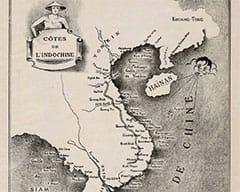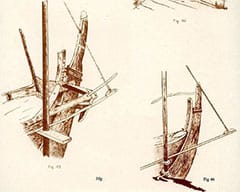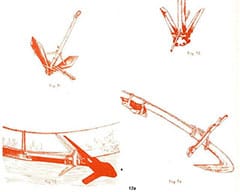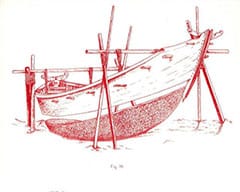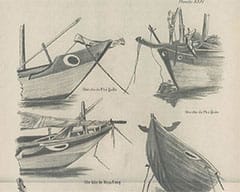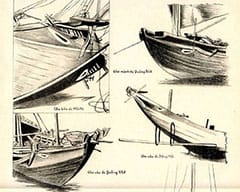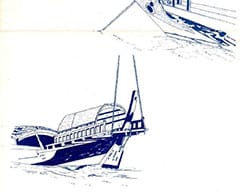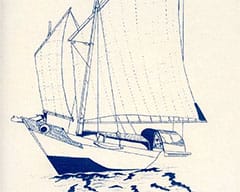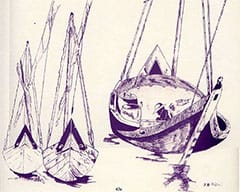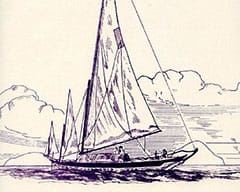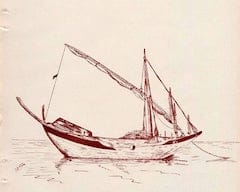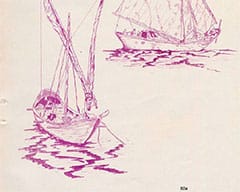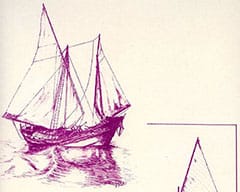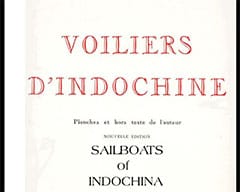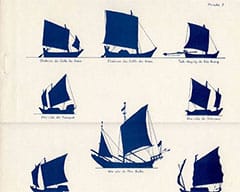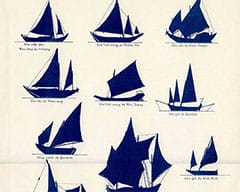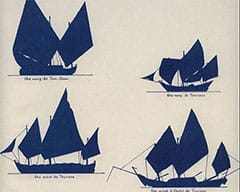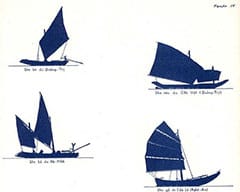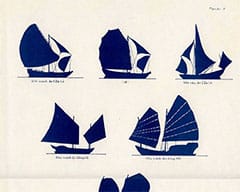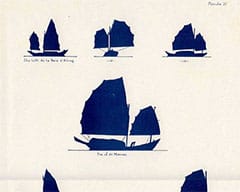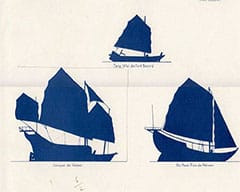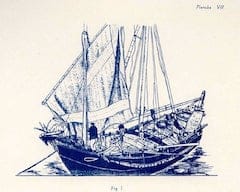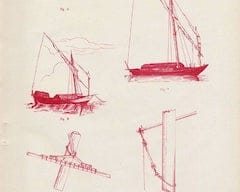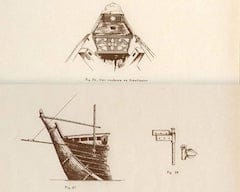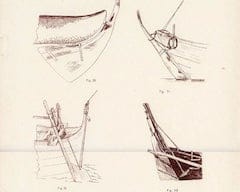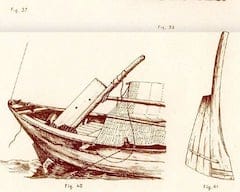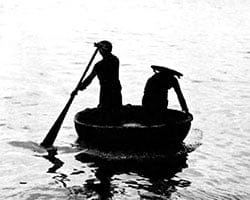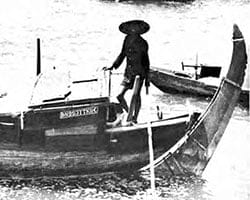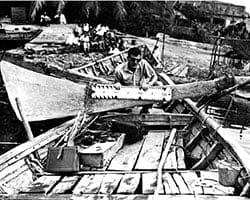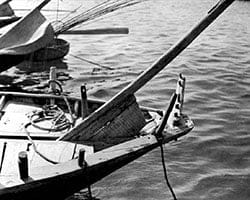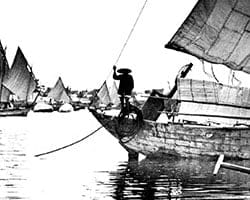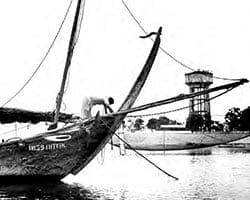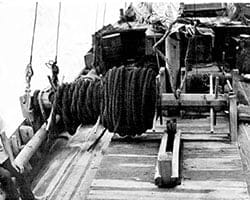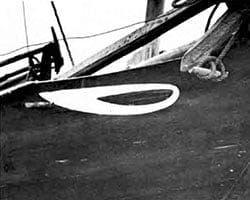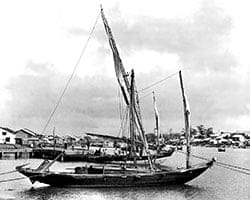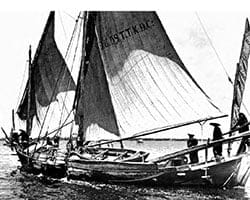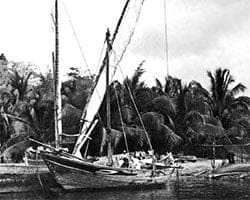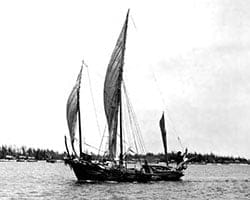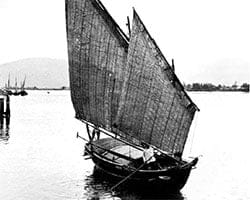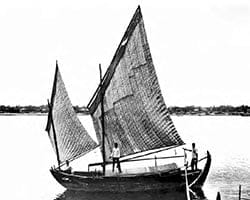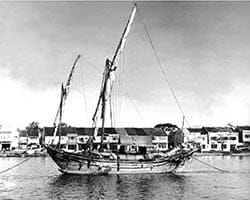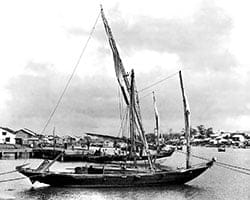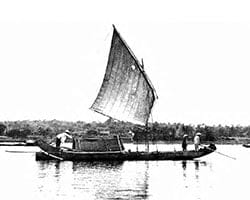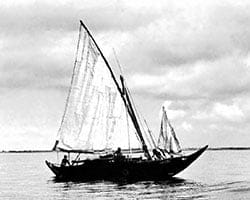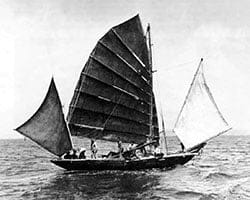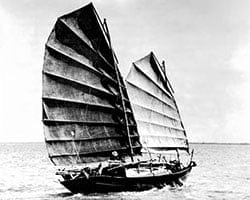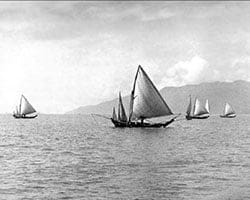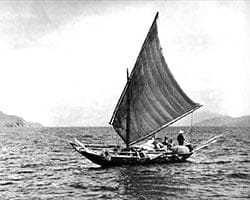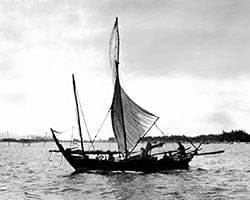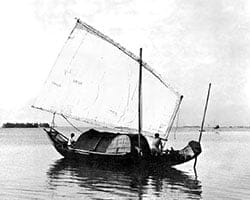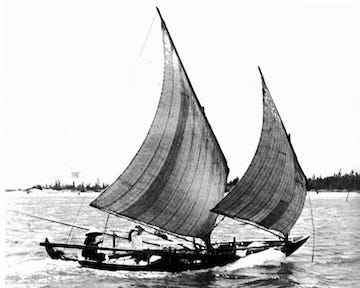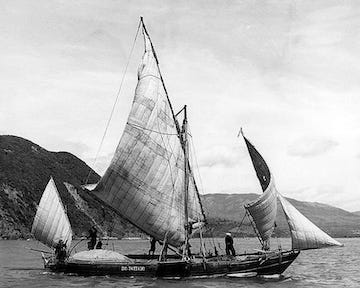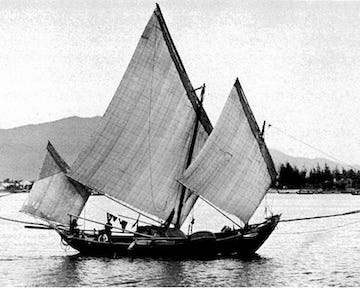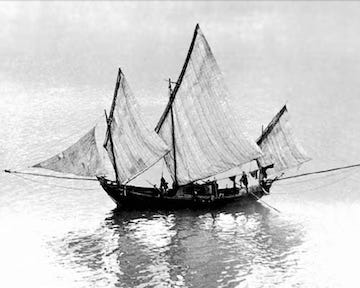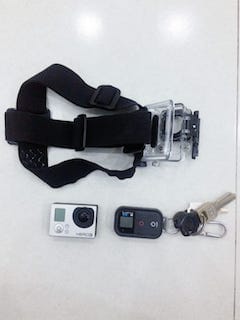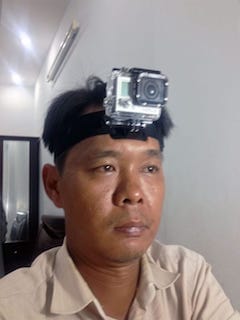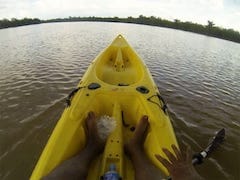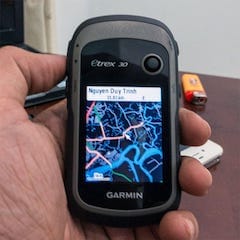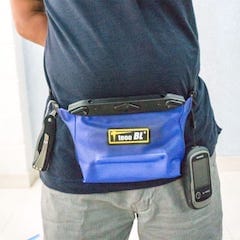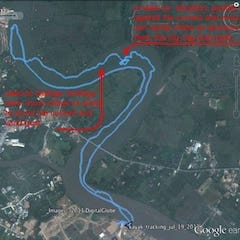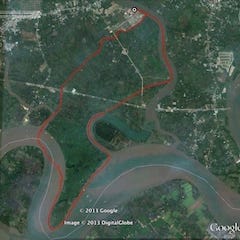 r. Piétri was a biologist, and a biologist in the old days was trained in pen, ink anatomical drawing. His skill came into great uses for boats illustration. His writing style is that of a romantic, nostalgic, old – school sailor, he was describing something that would soon pass away in Indochina, as it already had in the Western world: large fleet of sailboats in their daily activities: fishing, cargo transporting… He provided various information into a beautiful world that has now gone, even today we still can find wood – workers who possess the knowledge of building traditional hulls in VN (the number of them can be counted with fingers on your hands), some in – depth details like blocks, tackles, shackles, lines, sails, rigging… can only be found in his book.
r. Piétri was a biologist, and a biologist in the old days was trained in pen, ink anatomical drawing. His skill came into great uses for boats illustration. His writing style is that of a romantic, nostalgic, old – school sailor, he was describing something that would soon pass away in Indochina, as it already had in the Western world: large fleet of sailboats in their daily activities: fishing, cargo transporting… He provided various information into a beautiful world that has now gone, even today we still can find wood – workers who possess the knowledge of building traditional hulls in VN (the number of them can be counted with fingers on your hands), some in – depth details like blocks, tackles, shackles, lines, sails, rigging… can only be found in his book.
voiliers d’indochine – 1
 onsieur Piétri was Director of Fisheries of Colonial French Indochina (Vietnamese: Giám đốc nha ngư nghiệp Đông Dương), his career may had taken him to many watery parts of Vietnam, but only his passion for boat and sailing that resulted in Voiliers d’Indochine (Sailboats of Indochina), a book he’d spent many years working on, in the 30s the previous century, first published in Saigon, 1943, two decades ahead of The Junk Blue Book. I was reading it through an English translation of The Vietnam wooden boat Foundation, and its foreword:
onsieur Piétri was Director of Fisheries of Colonial French Indochina (Vietnamese: Giám đốc nha ngư nghiệp Đông Dương), his career may had taken him to many watery parts of Vietnam, but only his passion for boat and sailing that resulted in Voiliers d’Indochine (Sailboats of Indochina), a book he’d spent many years working on, in the 30s the previous century, first published in Saigon, 1943, two decades ahead of The Junk Blue Book. I was reading it through an English translation of The Vietnam wooden boat Foundation, and its foreword: dedicate to Mr. J B Pietri in recognition of his passion to accurately record the creativity and ingenuity of the Vietnamese people in the building of unique wooden boats…
the junk blue book – 3
 he Junk Blue Book – Marion C. Dalby, by its mission definition, is to provide knowledge to help identifying various Vietnamese indigenous boats, a military technical manual to be precise, not a book about boat design and construction. However it’s among the very rare well – written and fully – illustrated documents available today for us to know how, just half a century ago, our ancestors were operating sailing crafts.
he Junk Blue Book – Marion C. Dalby, by its mission definition, is to provide knowledge to help identifying various Vietnamese indigenous boats, a military technical manual to be precise, not a book about boat design and construction. However it’s among the very rare well – written and fully – illustrated documents available today for us to know how, just half a century ago, our ancestors were operating sailing crafts. As in most of the world the working Vietnamese seamen had little interest in chronicling their environment, or perhaps they had no idea that such everyday life would be of interest to anyone…
VN people is, as always, extremely easy to forget the past, and we’re today placed at a fait accompli
of a now vanished culture!
Around mid 20th century, the Age of Sail has been long over in the Western world, while in Indochina, sailing crafts were widely used still, and Westerners came to VN seeing them from a “recreational sport” point of view. Many of whom were surprised by the diversity in boat designs and constructions, some were astonished by unique features that only VN boats have, some admired the beauty and performance characteristics of certain VN sailing crafts. One such person is J.B. Piétri and his book Voiliers d’Indochine (Sailboats of Indochina). A marvellous book, no photographs, but all beautiful hand – drawn sketches, not only do they clearly show technical details, but also illustrate the other artistic side of the subject. To be presented in my up – coming posts!
the junk blue book – 2
 ore pictures from The Junk Blue Book – Marion C. Dalby, more about cargo boats (the previous post presents mainly fishing boats). First image in the series: a typical ghe bầu, the main “work – horse” of Southern people in the old days, ancestor of cargo boats usually seen in the Mekong delta nowadays (though the hull shape has changed significantly with introduction of combustion engine, I suppose). At the time of The Junk Blue Book, boats of this type were usually found around 100 ton in displacement, though in previous centuries, they were often constructed bigger at a few hundreds ton to be used for both trading and naval purposes. Ghe bầu composed the ‘spiral – cord’ of Vietnamese landlords’ navies in feudal time.
ore pictures from The Junk Blue Book – Marion C. Dalby, more about cargo boats (the previous post presents mainly fishing boats). First image in the series: a typical ghe bầu, the main “work – horse” of Southern people in the old days, ancestor of cargo boats usually seen in the Mekong delta nowadays (though the hull shape has changed significantly with introduction of combustion engine, I suppose). At the time of The Junk Blue Book, boats of this type were usually found around 100 ton in displacement, though in previous centuries, they were often constructed bigger at a few hundreds ton to be used for both trading and naval purposes. Ghe bầu composed the ‘spiral – cord’ of Vietnamese landlords’ navies in feudal time.
According to records of Western missionaries, adventurers, soldier – of – fortunes… who worked in Vietnam in the late 18th century, the Nguyễn and Tây Sơn lords’ navies both had a few 70 – guns mans – of – war, built and equipped to Western designs, but the majority is of ghe bầu type, with 20 ~ 60 guns mounted, capable of transporting upto 700 troops. Though these facts are likely, they’re still vague descriptions, there’s a lack of details and evidences. 50 – guns warship is a very strong frigate indeed, could be classified as 4th – rate ship – of – the – line, par the Royal Navy rating system, and should have the displacement at least at 1,000 (metric) tons, a question mark whether Vietnamese traditional boat building at the time was having such a capability.
the junk blue book – 1
 ore pictures from The Junk Blue Book – Marion C. Dalby. Some history background: in the early 60s, Northern Vietnam government (DRV) started an infiltration campaign to support the Southern communists by way of sea. The task force, designated: Group 579, deployed numerous boats, built and camouflaged as Southern fishing or cargo boats, smuggled weapons and war materials onto various spots along southern coast below the 17th parallel. The advantages of secret lines of boats are obvious: only need a small number of well – trained sailors, much larger cargo capacity, harder to trace and intercept (compared to e.g: transporting by trucks, which required lots of labours for road building and protecting, which is hard to keep secret).
ore pictures from The Junk Blue Book – Marion C. Dalby. Some history background: in the early 60s, Northern Vietnam government (DRV) started an infiltration campaign to support the Southern communists by way of sea. The task force, designated: Group 579, deployed numerous boats, built and camouflaged as Southern fishing or cargo boats, smuggled weapons and war materials onto various spots along southern coast below the 17th parallel. The advantages of secret lines of boats are obvious: only need a small number of well – trained sailors, much larger cargo capacity, harder to trace and intercept (compared to e.g: transporting by trucks, which required lots of labours for road building and protecting, which is hard to keep secret).
The US Navy took countermeasures, first by carrying out a study on VN indigenous boats: designs and constructions, outer appearances, sail plans, navigational equipments, operational zones and routes, methods and habits of fishing… in an effort to help identifying which are real Southern VN boats, and which are camouflaged Northern ones. The result is The Junk Blue Book, the study was taken place at a time when the majority of VN boats (over ~ 70%) was still operating primarily on sails. Ironical facts of history, that a work conducted initially against Vietnamese people, has now turned into a record of knowledge on Vietnamese sailing tradition, a tradition that has been long forgotten by its owner, very few people still care or even aware of it nowadays!
les flots du…
Một dòng sông sâu, cuồn cuộn sóng, trôi về nơi đâu?
Gió đưa buồm nâu, mang tâm hồn, vào cõi u sầu!
 ome pictures from The Junk Blue Book – Marion C. Dalby (Vietnamese title: Hải thuyền thanh thư). Despite some little efforts here and there (to recreate at least one functional Vietnamese – traditional sailing watercraft), a brilliant tradition had been lost, for more than half a century, virtually nowadays, none still possesses the full knowledge on Vietnamese sailing as it was the old days.
ome pictures from The Junk Blue Book – Marion C. Dalby (Vietnamese title: Hải thuyền thanh thư). Despite some little efforts here and there (to recreate at least one functional Vietnamese – traditional sailing watercraft), a brilliant tradition had been lost, for more than half a century, virtually nowadays, none still possesses the full knowledge on Vietnamese sailing as it was the old days.
We now can only view these beautiful images and admire a heritage that had long ceased to exist 😢! Anyone care to know can download a PDF copy (40 MB) of The Junk Blue Book (bilingual, English and Vietnamese texts in parallel columns) directly here, lots of details on VN indigenous boats, and lots of interesting images too!
…in minor scale
 tay at the 15 ~ 16 kilometers level for quite long already and can’t proceed further, it’s just because of my limited time. In order to practice beyond the 20 km range, it would probably take up whole day, not within a single morning or afternoon that I’m currently restricted. Anyway, I’m trying to keep up a good sustaining speed at 5 km per hour (GPS – measured with my Garmin, consider the plastic touring – boat I’m using a kind of clumsy and heavy design), and improving my endurance as well: continuous paddling in 3 ~ 4 hours couldn’t cause much fatigue for me, even at noon while the tropical sun is burning “fabulously”. Experiments with backward – looking camera mounting, too bad that it was raining and so gloomy today for a good video shot!
tay at the 15 ~ 16 kilometers level for quite long already and can’t proceed further, it’s just because of my limited time. In order to practice beyond the 20 km range, it would probably take up whole day, not within a single morning or afternoon that I’m currently restricted. Anyway, I’m trying to keep up a good sustaining speed at 5 km per hour (GPS – measured with my Garmin, consider the plastic touring – boat I’m using a kind of clumsy and heavy design), and improving my endurance as well: continuous paddling in 3 ~ 4 hours couldn’t cause much fatigue for me, even at noon while the tropical sun is burning “fabulously”. Experiments with backward – looking camera mounting, too bad that it was raining and so gloomy today for a good video shot!
Backward:
Forward:
gopro
 ons: buggy, can cause lots of frustration until you’d learned some hand – on experiences with it, image quality is not really good under sub – optimal lighting conditions, short battery life… Pros: simple handling, great protections for outdoor uses (the case is water – proof up to 60m), have tons of accessories for all your needs: diving, racing, skiing… lots of software options and settings to try out… A demo video below, you may recognise the background music: Deep Purple’s Highway Star 😀, once one of my favourite songs! It’s only when reviewing this clip did I realise that traffic is very dangerous nowadays in Saigon (or never has it been safe!?). Should we ban motorcycle completely, I would be happy with my bicycle then!
ons: buggy, can cause lots of frustration until you’d learned some hand – on experiences with it, image quality is not really good under sub – optimal lighting conditions, short battery life… Pros: simple handling, great protections for outdoor uses (the case is water – proof up to 60m), have tons of accessories for all your needs: diving, racing, skiing… lots of software options and settings to try out… A demo video below, you may recognise the background music: Deep Purple’s Highway Star 😀, once one of my favourite songs! It’s only when reviewing this clip did I realise that traffic is very dangerous nowadays in Saigon (or never has it been safe!?). Should we ban motorcycle completely, I would be happy with my bicycle then!
barcarolle
Đến đây với tôi cánh buồm đỏ thắm xa vời…
 xperimenting with this new kind of first person shooting (on a second thought, almost any photo and video are first person’s view, aren’t they!?). Let press play, then press the fullscreen button to see the 720p, and turn on the speakers too. I don’t have much video shooting and editing experiences, but the up – coming capturings (to be uploaded in the next few weeks) would be better, I promise! 😀
xperimenting with this new kind of first person shooting (on a second thought, almost any photo and video are first person’s view, aren’t they!?). Let press play, then press the fullscreen button to see the 720p, and turn on the speakers too. I don’t have much video shooting and editing experiences, but the up – coming capturings (to be uploaded in the next few weeks) would be better, I promise! 😀
About the music: it’s a Vietnamese interpretation (sung by Mỹ Linh) of Tchaikovsky – The Seasons‘ 6th piece named: June – Barcarolle, usually known in Vietnamese under the titles: Tháng sáu (June) or Chèo thuyền (Barcarolle). Yet it’s a bit late (now is August already, not June anymore) but anyhow, wonderful are the enjoying moments! 😀
Solo:
Tandem:
garmin
Beau le bateau, dansant sur les vagues,
Ivre de vie, d’amour et de vent.
Belle la chanson naissante des vagues,
Abandonnée au sable blanc!
 ros: ruggedised, water – proof (to IPX – 7 standard only), good battery life (uses 2 AA batteries, I can usually make 4, 5 paddling “sorties” before having to recharge), good display (clearly visible under sunlight with low – LCD – backlight setting), doesn’t depend on cellular network to function like a cellphone, could use both GPS (US) and GLONASS⓵ (Russia) satellites’ signal, good 3D – stabilized digital compass to show directions (very useful for navigating even on rivers.
ros: ruggedised, water – proof (to IPX – 7 standard only), good battery life (uses 2 AA batteries, I can usually make 4, 5 paddling “sorties” before having to recharge), good display (clearly visible under sunlight with low – LCD – backlight setting), doesn’t depend on cellular network to function like a cellphone, could use both GPS (US) and GLONASS⓵ (Russia) satellites’ signal, good 3D – stabilized digital compass to show directions (very useful for navigating even on rivers.
Sometimes, the river is so wide that I can hardly find correct heading based solely on its 2 banks’ landmarks), large internal storage space plus the ability to add an external memory card to store more maps. Cons: the Garmin’s default map is very vague on Vietnam’s territories, next to unusable, GUI responsiveness is slow compared to a smartphone’s standard. Most importantly, correct and content – rich maps are very much demanded:
General map
I’ve replaced my Garmin’s default map by Open Street Map, which is much better. However, Open Street Map, and even Google Map, are somewhat outdated for many parts of Vietnam. I’ve found out some places which are not right, even in the very vicinity of Saigon.
Topographic map
Thanks to NASA’s satellite image projects, the topographical information is now available publicly for most part of the globe, in high resolution. I’ve found these data built – in into Open Street Map already, so “the contours” are available on my Garmin.
Hydrographic map
I’ve long been collecting hydrography data, but there’s very few of them for Vietnamese water, and most are for blue – water regions, not the brown – water. Also, I’m still seeking a way to convert those data into Garmin map format to make them usable.
Tidal charts
Garmin supports displaying tidal information (given it is in the map), but unfortunately, those information for Vietnamese water is virtually zero. For me, this is currently the most important issue. Southern VN belongs to an area with complex mix of diurnal and semi – diurnal tides (Vietnamese: nhật triều & bán nhật triều). The highs and lows of tide within a single day can differ by 2 ~ 4 meters or more, which could make paddling very difficult, or even impractical at times (e.g: spring tide at new moon phase). For now, I consult this tides4fishing.com website to do the planning prior to going to the fields.
⓵⏎ From iPhone – 4S onward, Apple includes a GLONASS receiver into its hardwares, this explains the exceptional positioning performance of the devices. In term of precision, GLONASS is better than GPS at higher latitudes, but slightly behind GPS elsewhere. The use of both systems greatly extend signal coverage: GPS alone has 31 satellites, a receiver working with both GPS and GLONASS will have support from a total number of 55 (31 + 24) satellites, which improves signal fixing time, improves tracking performance and even precision would also receive a boost.




